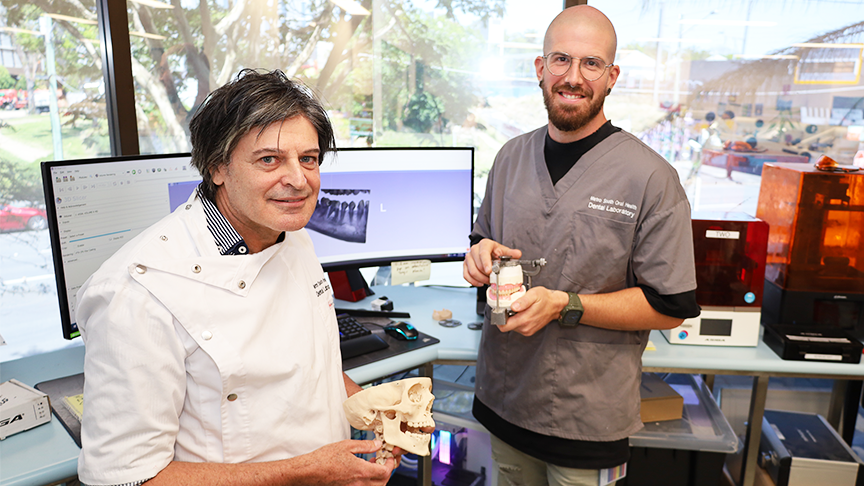
A team from Metro South Oral Health is transforming the landscape of dental technology with the integration of advanced 3D printing, artificial intelligence (AI), and cutting-edge materials. The team, led by industry veterans, David Hayes, and Sam Llyod, have tackled complex challenges that once seemed insurmountable, paving the way for a new era in dental care.
The process began with a simple yet ambitious goal: to improve the precision and speed of creating dental prosthetics such as dentures and crowns. However, as the team quickly discovered, venturing into the world of digital dentistry wasn't without its obstacles.
"We were quickly given the equipment, but there was no manual," explains Sam
"And even though there were courses available, the materials we were working with were so new that we had to navigate through a maze of regulatory hurdles, including getting Therapeutic Goods Administration approvals for our materials."
One of the biggest breakthroughs came when the team began experimenting with new 3D printing materials for dentures. Sam, who joined the team a few years ago, was instrumental in developing the structure and workflow for 3D printing in the lab.
"We started off with hollow dentures, designed to replace large amounts of bone and tissue. The challenge was ensuring they were light enough for comfort, but strong enough for durability,"
As the team experimented with these materials, it became clear that 3D printing held the key to creating dental solutions that were impossible to make with traditional methods. For example, once a 3D-printed tooth was created, it would be duplicated in materials like ceramic, which have been used in dental work for decades. This step ensured the prosthetics met clinical standards and could be used safely with patients.
"The accuracy of 3D printing is unparalleled," says David Hayes, an expert in the use of AI in dental imaging.
"We're talking about precision down to 25 microns—about the width of a human hair. It’s so accurate that we can create titanium teeth that fit directly into the sockets, something that was previously unthinkable."
David's work, which combines AI with traditional dental imaging techniques, has also led to the development of revolutionary tools for surgeons. By merging data from MRIs and cone beam scans, AI algorithms can now detect bone discrepancies and soft tissue details with extraordinary clarity.
"AI helps us identify nuances in scans that would be difficult for the human eye to detect. For instance, we can now see the precise angle of teeth roots, ensuring they don’t interfere with vital structures like the sinuses," says David.
The team’s collaboration with surgeons has been pivotal in applying these digital advancements in real-world clinical settings.
"Having AI-driven tools that provide accurate visualisations is changing the way we approach dental surgery," David adds.
"It’s giving surgeons clearer insights into patient anatomy, allowing them to make more informed decisions and ultimately improving patient outcomes."
One of the most notable applications has been the creation of obturators—devices that help patients with cleft palates or facial injuries.
"The feedback from patients has been incredible," said Sam.
"The new 3D-printed obturators are incredibly lightweight, and they form a perfect seal, which is essential for preventing food or liquids from coming out of the nose. It's a life-changing improvement for many patients."
Sam also emphasised the emotional impact of these advances.
"For patients who have had difficult journeys, like those with cleft palates or major facial injuries, the ability to provide a lightweight, perfectly fitting prosthetic is more than just a technical achievement—it’s about restoring confidence and improving quality of life."
While these advances in digital dentistry are making waves in the industry, the team’s success is built on years of collaboration, innovation, and trial and error.
"We had to combine multiple pieces of software to achieve the results we wanted," Sam explains.
"It was a real problem-solving journey, but the end results have been incredible."
Despite the immense progress, the team is quick to acknowledge the hard work of everyone involved, from technicians and lab managers to the medical professionals and software developers who made it all possible.
"The collaboration here has been amazing," says David.
"We have a diverse group of people with different skill sets, and everyone has contributed in ways we never expected."
For now, the team is focused on their next challenge: improving the speed and efficiency of their workflows to handle more complex cases—such as trauma patients who need immediate dental care.
"In the future, we aim to reduce production time even further, possibly cutting it down to just 48 hours for trauma cases," says Sam.
"We’ve already shaved days off the process, and we’re working hard to keep pushing those limits."
"At the end of the day, it’s all about the people we’re helping," says Sam.
"Seeing the difference we can make for someone who has struggled with dental issues for years—it’s incredibly rewarding."